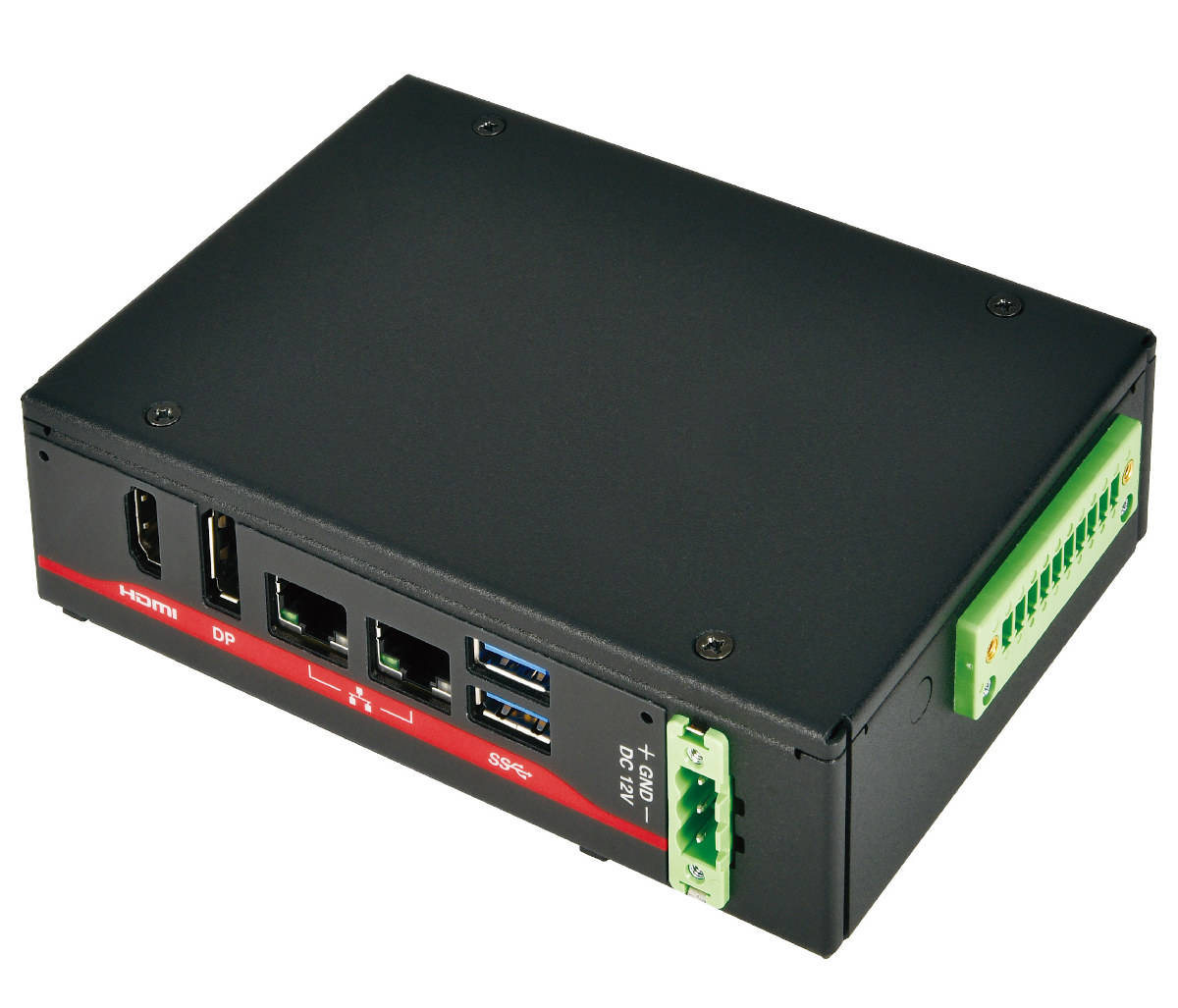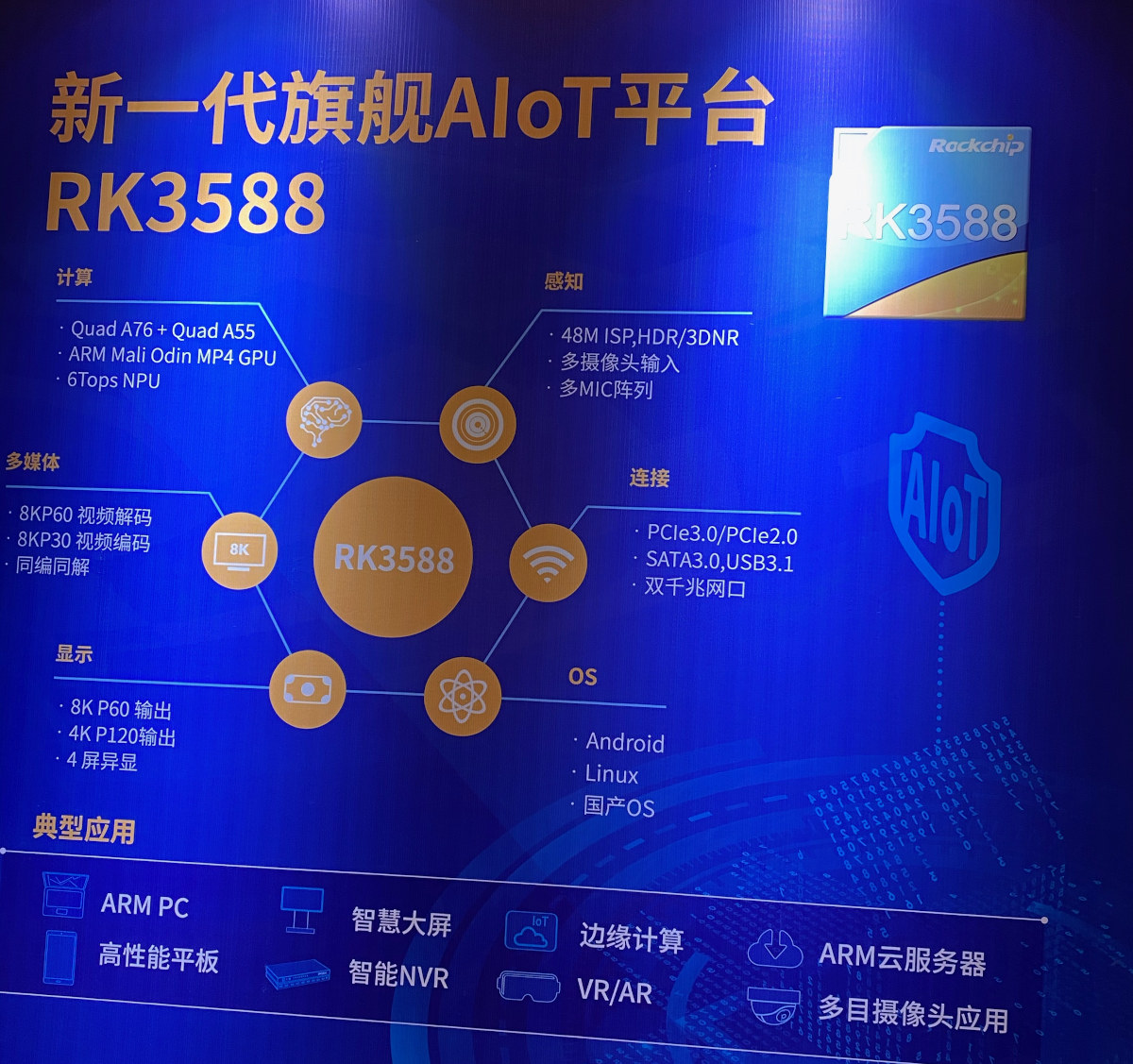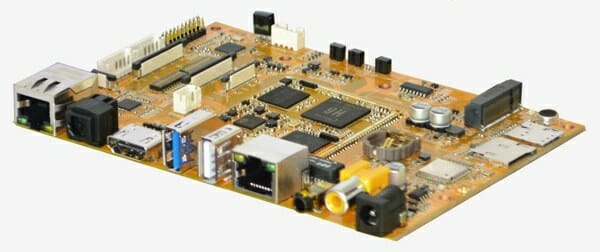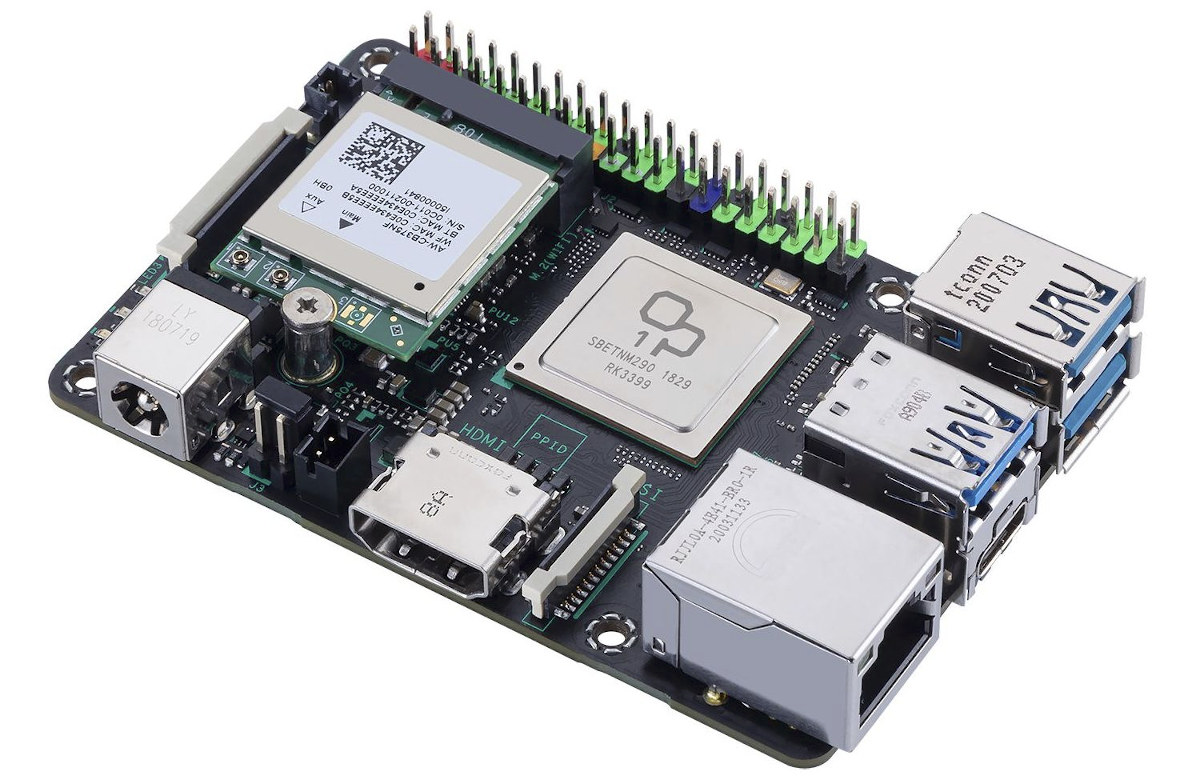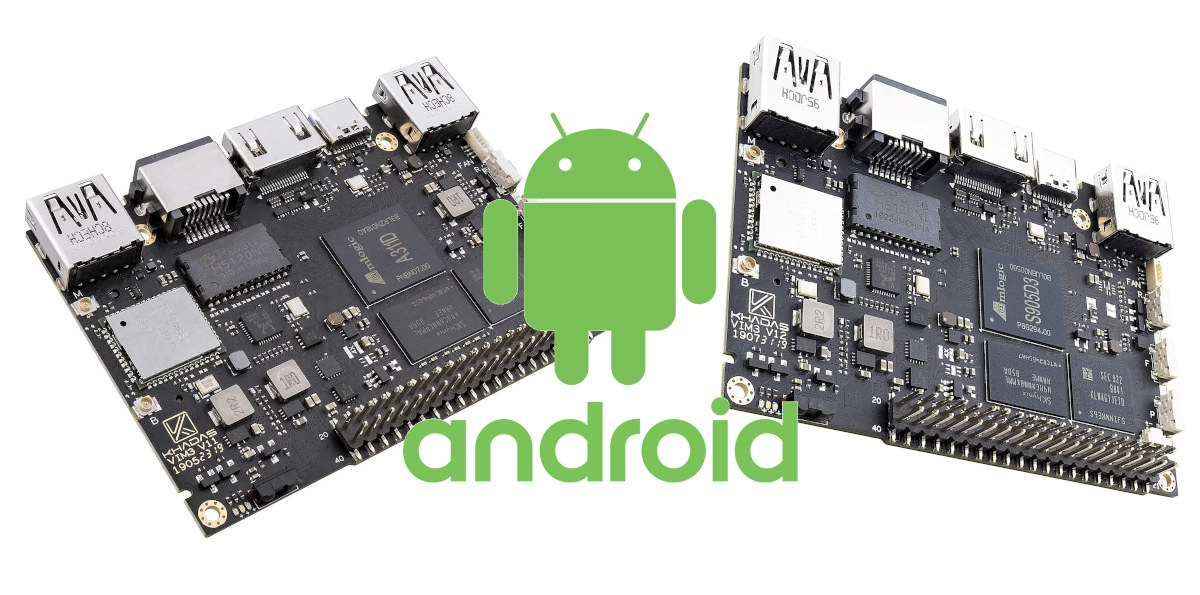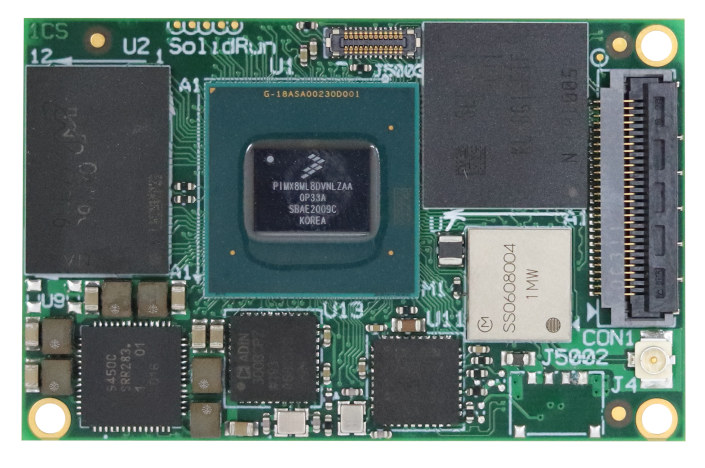ICP Germany has recently introduced the MiTAC ME1-8MD series family of compact, fanless Linux embedded systems powered by NXP i.MX 8M processor and designed to be used as IoT gateways, data acquisition and processing systems, and mini servers. Three models have been launched with a choice of dual or quad-core processors, up to 4GB LPDDR4 RAM, and 32GB eMMC flash storage. The embedded computers also come with up to two Ethernet ports, support up to two displays, and include an internal Raspberry Pi compatible 40 pin GPIO header. MiTAC ME1-8MD specifications and key features: SoC – NXP i.MX 8M Dual or Quad with two or four Cortex-A53 @ 1.3GHz, Cortex-M4 MCU, Vivante GC7000 Lite GPU, and 4K video processing unit System Memory – 1 to 4GB LPDDR4 800 Mhz RAM Storage – 8, 16, or 32GB eMMC flash, 1x MicroSD card slot up to 256GB Video Output HDMI 2.0 Optional […]
Rockchip RK3588 specifications revealed – 8K video, 6 TOPS NPU, PCIe 3.0, up to 32GB RAM
Rockchip RK3588 is one of the most anticipated processors for the year on this side of the Internet with the octa-core processor features four Cortex-A76 cores, four Cortex-A55 cores, an NPU, and 8K video decoding support. [Update December 2021: check out our post with the RK3588 datasheet for the latest details about the processor] The roadmap shows an expected launch date in Q3/Q4 2020, but sadly the release date will be pushed back in the future. Having said that, the Rockchip Developer Conference (RKDC) is now taking place, and the company has put up a poster that reveals a bit more about the processor. That means we now have more detailed Rockchip RK3588 specifications: CPU – 4x Cortex-A76 and 4x Cortex-A55 cores in dynamIQ configuration GPU – Arm Mali “Odin” MP4 GPU AI Accelerator – 6 TOPS NPU 3.0 (Neural Processing Unit) VPU – 8Kp60 video decoding support, 8Kp30 encoding […]
Allwinner H6 SBC offers dual Ethernet, four display outputs, M.2 expansion
While the processor was introduced in 2017, there are only a few Allwinner H6 SBC’s on the market with, for instance, Orange Pi 3 or Pine H64 boards, and it never became as popular as solutions based Allwinner H3 processor. But Boardcon has now launched its own Allwinner H6 SBC targeting professionals with Boardcon EMH6 board combining a carrier board and a computer-on-module that can be integrated into products. Boardcon EMH6 specifications: Core module SoC – Allwinner H6 quad-core Arm Cortex A53 processor with Arm Mali-T720 GPU with support for OpenGL ES3.1/3.0/2.0/1.1 System Memory – 1GB LPDDR3 Storage – 8GB eMMC Storage – MicroSD card slot, M.2 slot for NVMe SSD Video Output 1x HDMI 2.0a up to 4Kp60 1x CVBS interface 1x RGB interface or 2x eDP interface via NCS8801S RGB-to-eDP converter Backlight header Camera – 24-pin connector compatible with 13MP OV13850 camera sensor Audio – Optical S/PDIF output, […]
ASUS unveils Tinker Board 2 SBC with faster Rockchip RK3399/OP1 processor
ASUS surprised the maker community in 2017 with the introduction of the Rochchip RK3288 powered Tinker Board to compete as Raspberry Pi 3 Model B. It was followed by Tinker Board S with built-in storage and other new features, as well as Tinker Board Edge T and Edge R SBC’s both with an AI accelerator namely Google Edge TPU and the NPU inside Rockchip RK3399Pro. The company has now launched a new model called Tinker Board 2 without AI accelerator, but featuring Rockchip RK3399, or more exactly the higher grade Rockchip OP1 used in Chromebooks, delivering 96% faster single-thread performance and a 64% boost in multi-core performance compared to the Rockchip RK3288 processor found in the original Tinker Board, while the GPU is around 28% faster with glmark2-es2 off-screen benchmark. There are two variants of the board with Tinker Board 2 and Tinker Board 2S with the latter adding onboard […]
Reolink RLC-810A review – A 4K security camera with people & vehicle detection
Last week I received Reolink RLC-810A 4K smart security camera with support for people and vehicle detection. I listed the specifications and check out the content of the package of the first security camera I’ve received with artificial intelligence. That should be great to avoid all unnecessary alerts from motion detection I get from my “dumb” IP cameras. In this review, I’ll write a small guide showing how to use the camera with the Reolink app, the web interface, and check out RTSP and ONVIF support. I’ll also see if people and vehicle detection lives up to my expectations. Reolink RLC-810A Camera installation and setup As noted in the first part of the review, the camera does not come with a power adapter and does not support WiFi. So I had to find a 12V power adapter and used a 15-meter Ethernet cable to connect it to my router. Before […]
Khadas VIM3 & VIM3L SBC’s become Android reference boards
If you need to work on the very latest development version of Android or AOSP, you can either get one of the supported phones such as Google Pixel 5, one of the reference boards for Android which should be better for development and also fairly cheaper. We previously reported about Hikey, Hikey960, and DragonBoard 845c single board computers being part of the short list of reference boards for the Android Open-Source Project (AOSP), but Amlogic powered Khadas VIM3 and VIM3L have recently been added to the official devices page which makes them the first AOSP reference boards with a dedicated NPU / AI accelerator. As a quick reminder, Khadas VIM3 is the most powerful board with an Amlogic A311D hexa-core Cortex-A73/A53 processor with up to 4GB RAM and 32GB flash, and Khadas VIM3L is the light version with an Amlogic S905D3 quad-core Cortex-A55 processor with 2GB RAM and 16GB flash. […]
SolidRun launches i.MX 8M Plus SOM and devkit for AI/ML applications
SolidRun already offers NXP based solutions with AI accelerators through products such as SolidRun i.MX 8M Mini SoM with Gyrfalcon Lightspeeur 2803S AI accelerator, or Janux GS31 Edge AI server with NXP LX2160A networking SoC, various i.MX 8M SoCs and up to 128 Gyrfalcon accelerators. All those solutions are based on one or more external Gyrfalcon AI chips, but earlier this year, NXP introduced i.MX 8M Plus SoC with a built-in 2.3 TOPS neural processing unit (NPU), and now SolidRun has just unveiled the SolidRun i.MX 8M Plus SoM with the processor together with development kits based on HummingBoard carrier boards. Specifications: SoC – NXP i.MX 8M Plus Dual or Quad with dual or quad-core Arm Cortex-A53 processor @1.6 GHz (industrial) / 1.8 GHz (commercial), with Arm Cortex-M7 up to 800MHz, Vivante GC7000UL 3G GPU (Vulkan, OpenGL ES 3.1, OpenCL 1.2), 2.3 TOPS NPU, 1080p60 H.264/H.265 video encoder, 1080p60 video […]
Qualcomm QCC5141 Earbud reference design supports TrueWireless Mirroring and Hybrid ANC
Qualcomm has recently unveiled an earbud reference design based on the company’s QCC5141 low-power premium-tier Bluetooth SoC that supports TrueWireless Mirroring and Hybrid Active Noise Cancellation (ANC). What are TrueWireless Mirroring and Hybrid ANC? Qualcomm TrueWireless Mirroring technology relies on only one earbud to maintain the Bluetooth connection with the smartphone, while the secondary bud mirrors the connected bud. If the connected earbud is removed, the secondary earbud assumes the connection with zero interruption. The technology enables both a better, more stable connection and lower power consumption Hybrid Active Noise Cancellation (ANC) is designed to provide high-quality immersive experiences and enable natural leak-through of noise to allow for awareness of surroundings. Qualcomm ANC is fully integrated into this QCC5141 chip to reduce the complexity, cost, and PCB space of adding ANC to earbuds and hearables. QCC5141 Earburd Reference Design Key features and specifications: WiSoC – Qualcomm QCC5141 single-chip Bluetooth SoC […]


